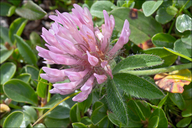|
|
click photo for larger file

Trifolium pratense ssp. nivale
Alpine Red Clover
|
Photographer: Dr. Amadej Trnkoczy
ID: 0000 0000 0414 0295 (2014-04-05)Copyright © 2014 Dr. Amadej Trnkoczy
|
|
INFORMATION PROVIDED WITH THE PHOTO
|
date of photo Aug 22, 2013
latitude 46.44198 longitude 13.64443
View on Google Maps.
location
Mt. Mangart flats, east of Mangart mountain road terminal loop, close to the bottom of the largest snow valley, East Julian Alps (Posočje, Slovenia)family
Fabaceae
notes Slo.: alpska črna detelja - Habitat: High mountain stony pasture; calcareous ground, full sun, moist ground; near the bottom of a large snow valley, exposed to direct rain, average precipitations ~ 3.000 mm/year, average temperature 1-3 deg C, elevation 1.975 m (6.500 feet), alpine phytogeographical region. - Substratum: soil. - Comment: Clovers are very common, agriculturally important plants and well known to everybody. Nevertheless, they are interesting and very diverse genus. There are more than fifty species and subspecies of this genus growing in Slovenia. In addition, especially some of them, like Trifolium pretense, are very variable. Even worse, there exist many different looking cultivars. The members of this genus grow from low land to alpine elevations. Distinguishing among them to species level is not always simple. Also species Trifolium pretense appears in many forms, which are taxonomically treated differently by different authors. The flowers can be from snow white, dirty white, pale purple, pink, yellowish …. Slovenian name 'črna detelja' translates to 'black clover', German name 'Rot-Klee' equals to English 'Red Clover'. In Austria they name it 'Schneeweisser Aplen-Klee', which means 'Snow-white Alpine Clover', although it is known that it has white flowers only in west Austria. So, flowers' color doesn't mean much regarding determination. - Even subspecies Trifulium pratense ssp. nivale can be of different colors. A better distinguishing trait for T. pretense group is apiculate, that means ending abruptly in a small, slender point (see Fig. 4.). For subspecies nivale such traits are leaflets with hairy surface and hairy, often reddish calyx with unevenly long and hairy calyx teeth, of cause, together with high elevations, where it grows. Flowers heads are surrounded by the uppermost steam leaves and have, like individual flowers, no stalks. - Ref.: (1) A. Martinči et all., Mala Flora Slovenije, Tehnična Založba Slovenije (2007), p 307. (2) M.A. Fischer, W. Adler, K. Oswald, Exkursionsflora Österreich, Liechtenstein and Südtirol, LO Landesmuseen, Linz, Austria (2005), p 570. (3) O. Angerer, T. Muer, Alpenpflanzen, Ulmer (2004), p 214 (4) K. Lauber and G. Wagner, Flora Helvetica, 5. Auflage, Haupt (2012), p 364.camera Nikon D700/Nikkor Micro 105mm/f2.8
contributor's ID # Bot_745/2013_DSC7639 photo category: Plant - annual/perennial
|
MORE INFORMATION ABOUT THIS PLANT
|
| common names
Alpine Red Clover (photographer)
View all photos in CalPhotos of Trifolium pratense ssp. nivale Check Google Images for Trifolium pratense ssp. nivale |
|
The photographer's identification Trifolium pratense ssp. nivale has not been reviewed. Click here to review or comment on the identification. |
|
Using this photo The thumbnail photo (128x192 pixels) on this page may be freely used for personal or academic purposes without prior permission under the Fair Use provisions of US copyright law as long as the photo is clearly credited with © 2014 Dr. Amadej Trnkoczy.
For other uses, or if you have questions, contact Dr. Amadej Trnkoczy amadej.trnkoczy[AT]siol.net. (Replace the [AT] with the @ symbol before sending an email.) |
|
|
